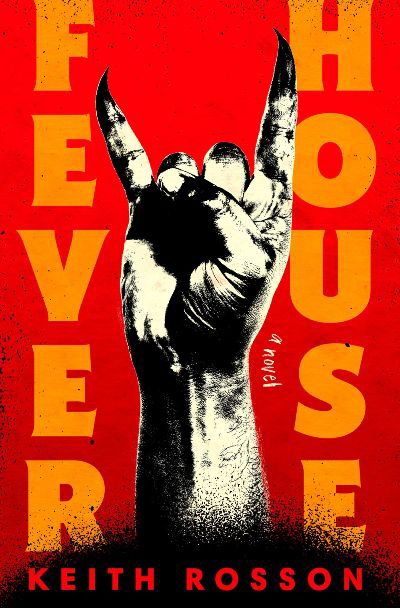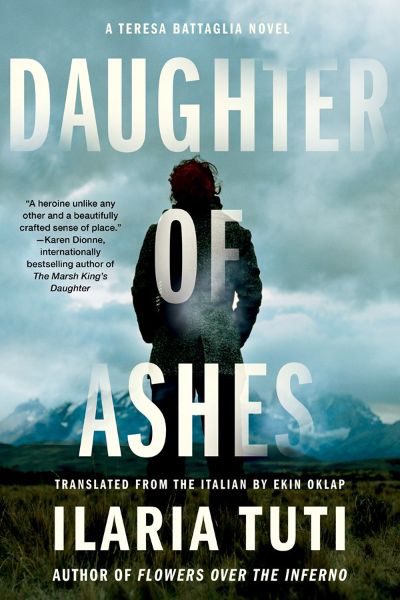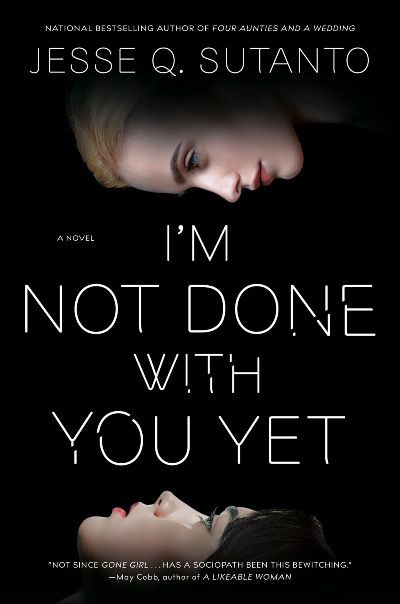In his acknowledgements, Rosson calls this “a wild fever dream of a novel,” and he nailed it. Where to start with this feral read? Since it’s a horror/suspense novel, the first gory moment seems apt: when a crime boss’s enforcers threaten a man with a drug addiction who owes a payment and the man asks, “What’re you gonna do? Knock my teeth out?” He then goes on to do the job himself, with his own filthy fingers. The enforcers find a severed hand during their work, one that causes those nearby to feel the need to do tremendous violence, the urge “[slithering] in. It floats on a dark wave.” The gore gets more sophisticated—“make me a necklace from the heads of your children…make me a red veil from their latticed veins”—only adding to the supernatural head-spinning. At the same time, we follow the life…if he or it is alive…of a being called Saint Michael, a secret captive of the U.S. government. Saint Michael can sometimes see visions of future events, especially when periodically “encouraged” by the agonizing process of government agents trimming his wings. In counterpoint to the government actions we meet a musician, Katherine Moriarty, who was very successful in her day but now is agoraphobic, her closed-in life perhaps related to the bizarre goings-on elsewhere in the novel. All converge in a terrifying episode in Portland, Oregon, that will surely be a highlight of the movie that is already being made of this terrific novel. Every word here is crafted to impart just the right level of revulsion, fear, and, at times, wonder. Get ready for awards nods for this work as well as comparisons to the works of Cormac McCarthy and Justin Cronin.
Thrillers
Judith and Katherine, or as they prefer, Jude and Kat, are mirror-image identical twins (they have the same features on opposite sides of their bodies, such as the same birthmark on opposite shoulders). But there is one big difference. Jude can remember all of their 22 years, but Kat has recently survived a terrible car accident that has left her with amnesia. Experiencing everything “again for the very first time,” she relies on Jude to tell her their life story, because, Jude says, their mother is dead and their father took off years ago. Some things seem puzzling, such as why the photos of their before-the-accident European trip don’t show the sisters at all, only landmarks. Readers learn why in those sections of the book that look at life before the crash, when the girls and their mother left mainstream society to live with the controlling King Bash, whose mantra was “What you think, is.” The pressure to will happiness and satisfaction into being, and the child abuse led by Bash, brews a toxic storm that Jude tries to keep in their past. But the past threatens to explode when a mysterious figure starts turning up at random places in the present. Kahler has a quietly compelling way of revealing secrets and of portraying a close sibling bond, creating an unusual debut novel (as Karen Abbott, Kahler is an Edgar Award nominee for Best Fact Crime for The Ghosts of Eden Park) that will be a hit with those who enjoyed the recent religious-cult documentaries Shiny Happy People and Keep Sweet: Pray and Obey
James L’Etoile uses his time working for the prison and criminal justice system to maximum effect at the start of this series featuring Detective Emily Hunter and her partner, Javier Medina. A businessman with ties to the Sacramento community is murdered in his home, and his wife is injured. The mayor wants answers and pressures Emily’s Captain to uncover the truth while ordering them to stay away from his widow. As the investigation progresses, the widow seems to have the answers they seek, but Emily and Javier risk being tossed off the case if they continue to prod her. More bodies start to appear, and a break-in reflects poorly on the dead businessman and his unscrupulous methods to maintain his job and charitable contributions. It doesn’t help that Emily is distracted by a family matter that seems to lead to a conclusion she cannot accept. The pacing and realistic feel of the investigation will appeal to fans of Michael Connelly, who enjoy a baffling crime to solve. Readers will be anxious for Emily’s next case.
This is the final book in Tuti’s stunning and disturbing trilogy starring police detective Teresa Battaglia and set in the Dolomite mountains of northern Italy. Teresa has always been an extraordinary character, a woman who fought her way up the police ladder—while suffering the ridicule of her male peers—and at the same time found herself caught in an abusive marriage that nearly killed her. Now in her early sixties, she has slowly acknowledged that she has Alzheimer’s, and in this book we see it beginning to dominate her life. But just as she is about to retire, Teresa is brought back to work on a case featuring Giacomo Mainardi, a serial killer she confronted 27 years ago, whose mind she has come to understand and whose soul she has come to respect. While very much the tale of a serial killer, this final volume finds Teresa finally accepting the love and support of her colleagues, putting aside the “thick and steely…armor she wore every day,” and acknowledging that she has paved “the way for all the other women who would follow, and for anybody—regardless of their sex—who might be vulnerable to being victimized by people in position of power.” Best to read this brilliant series in order, beginning with Flowers over the Inferno.
Isaka’s third book in this semi-series—the first, Bullet Train, was made into a popular film featuring Brad Pitt and Sandra Bullock—takes a bit of a departure. Yes, we’re focused on a genius hit man, in this case Kabuto. He’s beholden to the Doctor, an actual doctor who hilariously uses medical terminology as code to describe the hits. They’re oftentimes bizarre, wildly creative, or just plain funny. But Kabuto is over it. He wants out, except the Doctor isn’t ready to lose such talent and forces Kabuko to pay his way out, taking down some other professional assassins as his swan song. But for all the time we spend in Tokyo’s criminal underground, this book is more grounded in Kabuko’s life as a family man with a teen son and a wife, who are convinced his work is in office supplies! Kabuto’s relationship with his wife is uniquely fraught; he keeps a journal of phrases useful to appease her, while his son is remarkably loving towards his browbeaten dad. Featuring a professional killer who cringes because he ate the last of his wife’s favorite pudding, this book is poignant, sweet, and full of surprises. No need to read the earlier novels to appreciate this title.
This strange, beautiful tale wedges readers into the crowded boats and alleys of Venice while whisking them along on a three-day romance with a Roman princess and the down-at-heel tour guide she falls for. The two seem to float above the city’s watery fray even before meeting. After meeting, they withdraw completely into their own emotional realm, “literally liquefied” by their fascination and passion for each other. Time is immaterial, they agree, as they find themselves “precariously suspended between being and non-being,” contemplate “intimate perplexities on who is who, where the I ends and the you begins,” and eat “a variety of little inventions.” The love story, which as the translator’s note explains, features more robustly in the book than the crime tale related to the princess’s work as an art dealer, soon provokes questions in the reader. Where is the tour guide from? Why must he leave Venice despite his grief over losing the love he has just stumbled upon? The answer to the mystery is startling and brings up many questions about the nature of life and how the past, and past injustices, can resonate today. Try this after Danielle Trussoni’s The Puzzle Master; you’ll come back to Earth eventually
The brother/sister team of Boyd and Beth Morrison delivers a stellar sequel to The Lawless Land. Gerard Fox and Lady Willa are adventuring together in 1351 Italy, hoping to overcome their problematic societal pasts to marry. They stumble upon an ambush and help an older woman, Luciana, escape the attack. That act of kindness plunges them into a decade-old search for the location of the Templar treasure. It doesn’t help that Luciana’s greedy husband wants her dead and the treasure for himself. To succeed in their quest, Gerard and Willa must overcome betrayal, villainy, and deception while keeping the truth of their heritage secret. The Middle Ages comes to glorious life mixed with a plot from a Clive Cussler novel. The Last True Templar is adventure at its finest, and the pacing never slows down for a second. The story reads like the authors somehow have a time machine and are merely transcribing actual events. Readers will be anxious for the next book in the series, and hopefully a big-screen adaptation is not far behind.
This American Girl has nothing to do with dolls, and her life is anything but toy-store quaint. Pennsylvania high-school-senior Charlie is autistic, a reality she’s learned to mask by carefully studying TV characters and everyone in her life. She’s developed rules, ways for “a child like that” to understand the world, but some things remain unfathomable. People get harder or easier to look at, for example, depending on their behavior. Grandma threw Charlie and her mother out, because “whores get what whores deserve.” And making a friend is hard when adults fear that Charlie’s mom might not “[run] a home with the right values.” But she finally finds a haven in the Triple S, a sandwich store where she fits right in with the downtrodden coworkers, who are all struggling to stay afloat while avoiding the handsy, loathsome boss. When he’s found dead, and security camera footage shows Charlie witnessing something off camera that horrifies her, she’s placed firmly in the spotlight. This is an uncomfortable position and readers will root hard for her to leave, not least because MIT is waiting for this gutsy girl. Teens as well as adults will enjoy this smart kid’s inner life and Walker’s wry observations about small-town life.
The bitchiness we loved in Dial A for Aunties is back with a vengeance. This time, the author takes us, via flashbacks, to the nervous, early days of an American student at Oxford University. Jane Morgan’s mother has drilled into her daughter that she can’t write and can’t do anything else right either, and Oxford isn’t for the likes of her. So it’s a relief when Janemeets the confident, beautiful Thalia Ashcroft. For Jane, it’s obsession, if not love, at first sight. She’ll do anything to keep Thalia’s friendship, and is desperate to keep her from Ami, a blithely rich student who looks like competition for friendship with Thalia. It’s a struggle—everything’s so hard for Jane, who must continually remind herself that her sociopathic behaviors—“antisocial (check), hostile (check), irresponsible (check)”—must be kept under wraps if she’s to get ahead. Then everything unravels, a situation hinted at in the present-day section of the book as the time Jane left Oxford after an unnamed disaster. What happened, and how the women confront each other and the event’s aftermath all these years later, is a thrilling tale filled with twists, unreliable narrators, and absurdness of the best kind. For Dial A for Aunties fans and anyone who likes a friendship drama.
“Everybody knows everything about you in this stupid town. And they know nothing.” What people in Madeline Martin’s rural New York town know about her is that she’s the daughter of the town’s longtime, beloved sheriff and she owns The Next Chapter, her dream bookstore. They also know, but rarely mention, that she survived a brutal attack ten years before, one that saw her friend Steph murdered and two other friends, sisters Ainsley and Sam, disappear. What they don’t know is that Maddie’s never recovered emotionally and longs to know what happened to her friends. There’s still no word on the missing teens, and it’s a few days before the anniversary of the attack, which also means Christmas is a few days off and the bookstore is humming. Superstar author Harley Granger chooses this as his moment to visit and start his research on whether the man doing time for the crime is guilty, what happened to Ainsley and Sam, and, most urgently, where a newly disappeared exotic dancer could be. All breathlessly documented on social media, of course. Fans of Unger will know her thrillers match top-notch writing with gripping stories; this one won’t disappoint in that regard and offers the bonus of a satisfying family story in Maddie and her father.










